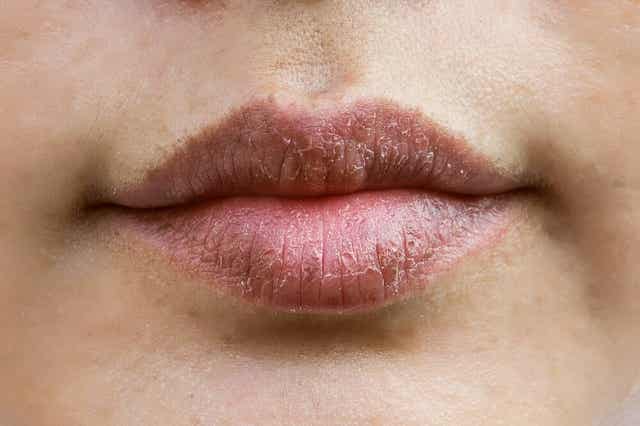Lanolin Wax: Uses and Recommendations

The sebaceous glands of wool-producing mammals, especially sheep, secrete a wax capable of waterproofing and protecting your skin from moisture. This is called lanolin wax, and it’s extracted while cutting wool. In addition, it prevents the animal from being harmed while shearing.
Often considered an animal fat, lanolin is an odorless, yellowish substance whose texture resembles petroleum jelly. Despite having different uses, it’s known for being a moisturizer that can be used to treat skin conditions like eczema.
Here, we’ll tell you everything you need to know about it.
Uses of lanolin wax

Known for its moisturizing effect, lanolin wax is hypoallergenic and has a bacteriostatic effect. In other words, although it can’t kill bacteria, it stops it from reproducing. This way, bacteria die without multiplying.
Similarly, it acts as an emollient, a substance that reduces calluses, softens and protects the skin, and fights eczema.
Therefore, it’s common for different fields to use lanolin, like the pharmaceutical and cosmetic industries. In general, you can find it in:
- Creams for medical and cosmetic use (moisturizers, makeup removers, shaving, anti-aging, diaper rash, and more)
- Makeup products like lipsticks, face powder, and more.
- Products and remedies to reduce dry scalp
- Soaps and detergents
- Products for polishing leather or shoe creams
- Make vitamin D
Check this out: Calcium and Vitamin D-Rich Foods to Care for Your Bone Health
Benefits for our skin
As you can see, lanolin is a famous emollient that can treat dry and dehydrated skin. A study published in Clinical Medicine & Research showed that it can reduce water loss from the skin by between 20 and 30%. It can hydrate, soften and improve the appearance of rough and scaly areas.
Now, these aren’t the only benefits that this natural wax can give your skin. We’ll show you some other ways it can help you.
Reduce wrinkles
Both lanolin oil and alcohol are common ingredients in anti-aging creams. Lots of people believe that it could be effective in reducing wrinkles and fine lines.
Although there’s little scientific evidence, these effects are associated with the fact that lanolin can contain twice its weight in water. Then, this adds volume to your skin and fights signs of aging.
Reduce hair dryness
Due to its emollient action that prevents hair loss, lanolin oil can help treat dry hair. You should always apply it when it’s damp or wet since if it’s dry, there will be no moisture to retain.
In addition, you will need to wash your hair with a deep cleansing shampoo or apple cider vinegar due to the waxy texture of this oil. That way, there won’t be any trace of the product.
Treat dry lips
Just like with dry skin and hair, lanolin oil treats chapped, cracked, and dry lips. According to a study published in the Journal of Applied Oral Science, lanolin cream successfully reduced the dry lips people going through chemotherapy experienced.
Similarly, this wax can penetrate the layers of your lips better than other substances that only reach the outer barrier. Also, it’s even safe to give to newborns with dry lips. However, it’s best to ask your pediatrician before doing so.
Heal cracked nipples
Cracked nipples are common during the breastfeeding process. For this reason, some specialists recommend applying lanolin to this area to relieve pain and stop bleeding.
Specialists believe that this wax can restore moisture to nipples. So, breastfeeding women can purchase 100% pure and refined lanolin wax. Be careful, because lanolin that isn’t pure could cause allergic reactions in infants.

Other benefits of lanolin wax for the skin
There are other ways that lanolin could contribute to skincare. Here are some great ones:
- Smooth roughness on your elbows and heels: dry skin causes roughness in areas like heels and elbows. In addition, dead cells can build up. You can use lanolin wax to soften them and remove dead skin.
- Treat diaper rash: moisture from diapers can cause irritation and inflammation to babies’ skin. Fortunately, lanolin serves as a buffer between moisture and infants’ skin.
- Heal minor burns: lanolin wax is associated with relief and taking care of injuries caused by fire and heat.
- Improving wound healing: lanolin has healing properties, which can speed up healing wounds and injuries.
Where to find it
Thanks to its properties and health benefits, you can find lanolin in a variety of commercial presentations.
These include:
- Pure lanolin (quality wax doesn’t have more than 0.25% water)
- Lanolin oil
- Lanolin alcohol
- Creams for medical and cosmetic use (anti-aging moisturizers, for diaper rash, for chapped nipples, among others)
- Beauty products (lip balms, masks, makeup removers, and more)
- Soaps, shampoo, conditioners, and body washes
Prevention and contraindications
For people without allergies, lanolin is safe to consume and use topically. However, ingesting large amounts of this wax, which is used to make vitamin D, is harmful. It can be toxic and tends to build up in the intestines. In general, lanolin can cause allergic reactions and food poisoning.
Next, we’ll explain what these scenarios are like.
Lanolin allergy
Since lanolin is the main cause of wool allergies, people with this condition should avoid it. This wax is a skin sensitizer; in other words, it’s a substance that triggers an allergic reaction when it touches the skin.
However, allergies to lanolin are very rare. According to a study published in the British Journal of Dermatology, only 1.7% of the 25,000 people prone to allergies had signs of this particular condition, The most common symptoms of an allergic reaction are swelling of the eyes, lips, and throat, a rash, and trouble breathing.
Lanolin poisoning
Lanolin poisoning can happen in several ways. For example, it could happen from swallowing the oil by mistake, or using too much lip balm and swallowing it from licking your lips. Its symptoms include diarrhea, vomiting, rash, inflammation, and skin redness.
Check this out: Types of Diaper Rash: Symptoms and Treatment
What to remember about lanolin
Lanolin is a natural wax that you get from animals that produce wool. These mammals produce it in their sebaceous glands and it protects wool from moisture, as well as to prevent injuries while shearing.
In general, it’s common in products for medical and cosmetic use, such as creams, shampoos, soaps, and detergents. Similarly, it serves as an ingredient in leather polishing products and shoe creams.
It has lots of benefits for health and skincare. Some believe that it can reduce wrinkles, treat dry lips, heal chapped nipples, and decrease hair and scalp dryness.
On the other hand, people with wool allergies shouldn’t use it since it can trigger a series of symptoms. Likewise, you shouldn’t ingest it, since too much could cause lanolin poisoning.
All cited sources were thoroughly reviewed by our team to ensure their quality, reliability, currency, and validity. The bibliography of this article was considered reliable and of academic or scientific accuracy.
- Purnamawati, S., Indrastuti, N., Danarti, R., & Saefudin, T. (2017). The Role of Moisturizers in Addressing Various Kinds of Dermatitis: A Review. Clinical medicine & research, 15(3-4), 75–87. https://doi.org/10.3121/cmr.2017.1363
- Santos, P. S., Tinôco-Araújo, J. E., Souza, L. M., Ferreira, R., Ikoma, M. R., Razera, A. P., & Santos, M. M. (2013). Efficacy of HPA Lanolin® in treatment of lip alterations related to chemotherapy. Journal of applied oral science : revista FOB, 21(2), 163–166. https://doi.org/10.1590/1678-7757201302308
- Wakelin, S. H., Smith, H., White, I. R., Rycroft, R. J., & McFadden, J. P. (2001). A retrospective analysis of contact allergy to lanolin. The British journal of dermatology, 145(1), 28–31. https://doi.org/10.1046/j.1365-2133.2001.04277.x
- Drugs and Lactation Database (LactMed) [Internet]. Lanolin. https://www.ncbi.nlm.nih.gov/books/NBK501842/
This text is provided for informational purposes only and does not replace consultation with a professional. If in doubt, consult your specialist.








